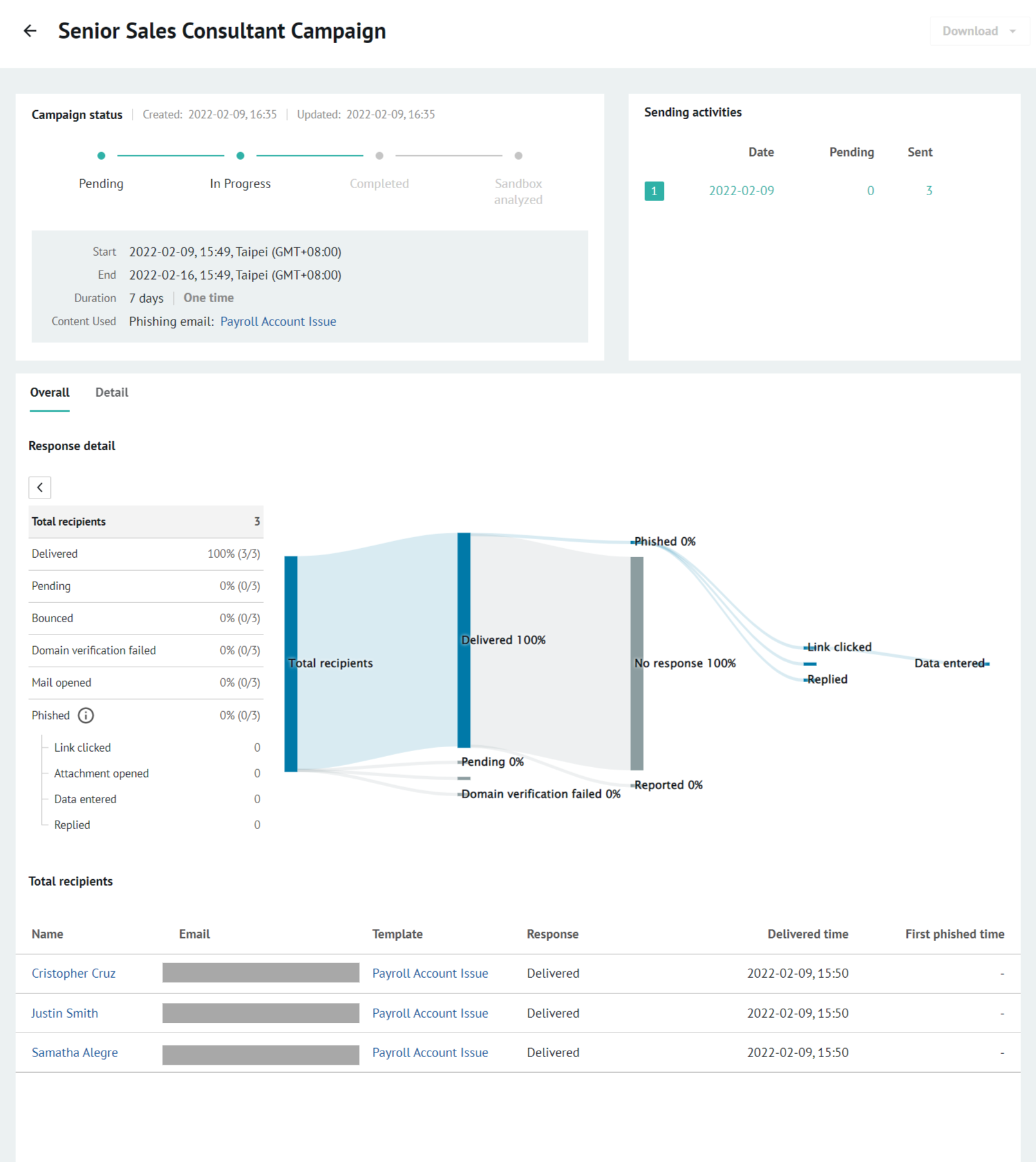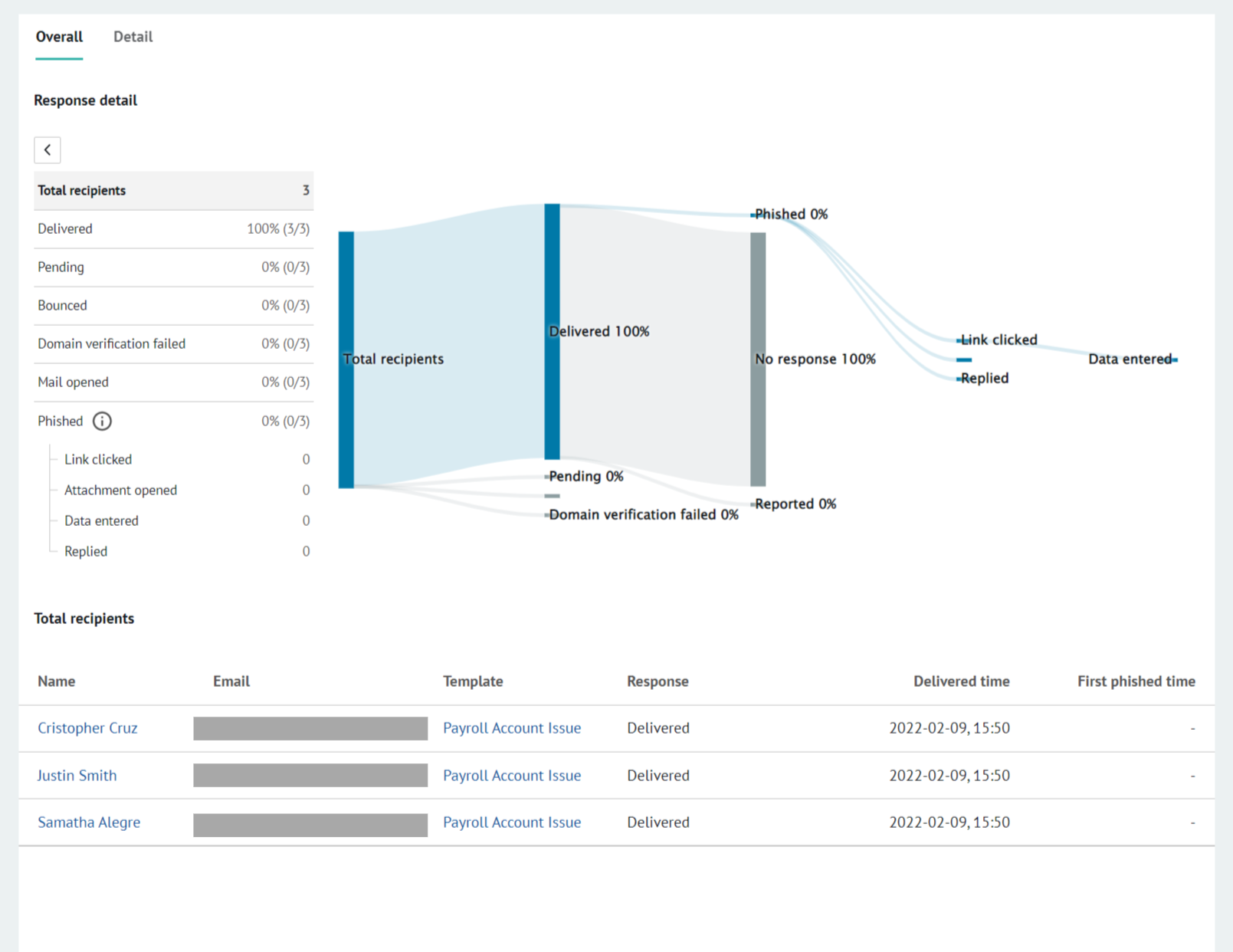TABLE OF CONTENTS
- Campaign Timeline
- How to view your simulation campaign details?
- Simulation campaign details page
- User Risk Behavior
Campaign Timeline
The Campaign Timeline shows the schedule of your campaigns that are in Pending, In-progress or Completed status. 
Campaigns are sorted according to their start date and time.
How to view your simulation campaign details?
- Login to Phish Insight
- On the Campaigns page under Simulation tab, Click the name of the campaign you want to view

- You will be redirected to the Simulation campaign details page
Simulation campaign details page
Breakdown of the Simulation campaign page

- Campaign name - name of the current campaign
- Download - download a copy of the Phished Users List or the Sandbox Analysis Report
Campaign status and details
- Campaign status
- Created - date and time when the campaign is created.
- Updated - date and time when the campaign details were recently updated
- Status progress bar - shows the current status of the campaign.
- Details
- Start - date and time when the campaign will start or when it started
- End - date when the campaign will end
- Duration - number of days the campaign or the current round will take place. This time frame includes the sending of phishing emails and the tracking of recipients' activities. It also includes frequency of the campaign.
- Phishing email - the phishing email template that the recipients will receive
- Start - date and time when the campaign will start or when it started
Sending activities
 If you choose to stagger the delivery of your campaign over a number of days you will see the sending activity summarized here.
If you choose to stagger the delivery of your campaign over a number of days you will see the sending activity summarized here.
- Round number - Example: if you are sending your campaign over three days you will see three sending rounds.
- Date - date when the email sending will take place
- Pending - number of pending phishing emails
- Sent - number of sent phishing emails.
Response detail
- Side menu - shows the status of all phishing emails in the current round or campaign
- Total recipients - total number of recipients in the campaign
- Delivered - shows all the recipients who received the phishing emails
- Pending - shows all the recipients whose phishing emails are waiting to be sent
- Bounced - shows all the recipients whose phishing emails were sent, but bounced
- Domain verification failed - shows all the recipients that has an unverified domain and did not receive the email
- Mail opened - shows all the the recipients who opened the phishing email (images in the email must be downloaded to be counted as "Opened".
- If the user just looks at the mail in preview mode it will not be counted as opened unless the images in the email are downloaded
- If the user double clicks on the email it will not be counted as opened unless the images in the email are downloaded.
- Phished - the percentage of recipients who displayed risky behavior when they received the phishing simulation. Risky behavior can be defined as one of the following:
- Clicked - recipient clicked the link in the phishing email
- Attachment Opened - recipient opened the attachment in the phishing email
- Data Entered - recipient entered data on the landing page
- Replied - recipient replied to the phishing email (this will only reflect if the Phishing Campaign is a BEC simulation)
- Total recipients - total number of recipients in the campaign
- Campaign chart - shows both the status of the phishing emails in the current round or campaign and the recipients' response in a graphical representation
- Total recipients table - shows all the users and their responses for this campaign
Note: You can click the email sending status in the side menu to filter the users in the table- Name - full name of the recipient
- Email - email address of the recipient
- Template - the email template that the recipient received
- Response - the latest responses of the user to the phishing email.
- Delivered time - date and time when the phishing email arrived at the recipient's inbox
- First phished time - date and time that the user was first considered phished by the simulation
User Risk Behavior
- Click on any user name if you want to view details of their behavior

- You will then see the Risk Behavior for the user.

- Link clicked - shows the user's IP address, browser, OS, date and time when the recipient clicked the phishing link in the phishing email
- Attachment opened - shows the user's IP address, browser, OS, date and time when the recipient opened the attachment
- Data entered - shows the user's IP address, browser, OS, date and time when the user entered data in the simulated landing page
- Replied - shows the date, time and text content of the users' reply